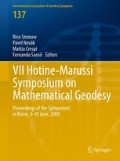Abstract
After an introductory note reviewing the role and the treatment of boundary problems in physical geodesy, the explanation rests on the concept of the weak solution. The focus is on the linear gravimetric boundary value problem. In this case, however, an oblique derivative in the boundary condition and the need for a numerical integration over the whole and complicated surface of the Earth make the numerical implementation of the concept rather demanding. The intention is to reduce the complexity by means of successive approximations and step by step to take into account effects caused by the obliqueness of the derivative and by the departure of the boundary from a more regular surface. The possibility to use a sphere or an ellipsoid of revolution as an approximation surface is discussed with the aim to simplify the bilinear form that defines the problem under consideration and to justify the use of an approximation of Galerkin’s matrix. The discussion is added of extensive numerical simulations and tests using the ETOPO5 boundary for the surface of the Earth and gravity data derived from the EGM96 model of the Earth’s gravity field.
Access this chapter
Tax calculation will be finalised at checkout
Purchases are for personal use only
References
Bers L, John F, Schechter M (1964) Partial differential equations. Wiley, New York
Holota P (1991) On the iteration solution of the geodetic boundary-value problem and some model refinements. Travaux de l’A.I.G., Tome 29, Paris, 1992, pp 260–289
Holota P (1997) Coerciveness of the linear gravimetric boundary-value problem and a geometrical interpretation. J Geodes 71:640–651
Holota P (1999) Variational methods in geoid determination and function bases. Phys Chem Earth Solid Earth Geodes 24(1):3–14
Holota P (2000) Direct method in physical geodesy. In: Schwarz KP (ed) Geodesy Beyond 2000, IAG Symposia, vol 121, Springer, New York, pp 163–170
Holota P (2001a) Variational methods in the recovery of the gravity field – Galerkin’s matrix for an ellipsoidal domain. In: Sideris MG (ed) Gravity, Geoid and Geodynamics 2000, IAG Symposia, vol 123, Springer, New York, pp 277–283
Holota P (2001b) Variational methods in the representation of the gravitational potential. Cahiers du Centre Européen de Géodynamique et de Séismologie, vol 20, Luxembourg, 2003, pp 3–11
Holota P (2004) Some topics related to the solution of boundary-value problems in geodesy. In: Sansò F (ed) V Hotine-Marussi symposium on mathematical geodesy, IAG Symposia, vol 127, Springer, New York, pp 189–200
Holota P (2005) Successive approximations in the solution of weakly formulated geodetic boundary-value problem. In: Sansò F (ed) A window on the future of geodesy, IAG Symposia, vol 128, Springer, New York, pp 452–458
Holota P, Nesvadba O (2008). Model refinements and numerical solutions of weakly formulated boundary-value problems in physical geodesy. In: Xu P, Liu J, Dermanis A (eds) VI Hotine-Marussi symposium on theoretical and computational geodesy, IAG Symposia, vol 132, Springer, pp 320–326
Krarup T (1969) A contribution to the mathematical foundation of physical geodesy. Danish Geodetic Institute, Publ. No. 44, Copenhagen
Lemoine FG, Kenyon SC, Factor JK, Trimmer RG, Pavlis NK, Chinn DS, Cox CM, Klosko SM, Luthcke SB, Torrence MH, Wang YM, Williamson RG, Pavlis EC, Rapp RH, Olson TR (1998) The development of the joint NASA GSFC and National Imagery and Mapping Agency (NIMA) geopotential model EGM96. NASA/TP-1998–206861, NASA, GSFC, Greenbelt, Maryland
Moritz H (2000) Geodetic Reference System 1980. The Geodesist’s Handbook. J Geodes 74:128–133
Nečas J (1967) Les méthodes directes en théorie des équations elliptiques. Academia, Prague
Nesvadba O, Holota P, Klees R (2007) A direct method and its numerical interpretation in the determination of the Earth’s gravity field from terrestrial data. In: Tregoning P, Rizos C (eds) Dynamic Planet, IAG Symposia, vol 130, Chap. 54, Springer, New York, pp 370–376
Neyman YuM (1979) A variational method of physical geodesy. Nedra, Moscow (in Russian)
Rektorys K (1974) Variaicný́ metody v inizenýrských problémech a v problémech matematické fyziky STNL, Praha. (In Czech)
Rektorys K (1977) Variational Methods. Reidel, Dordrecht-Boston
Sansò F (1986) Statistical methods in physical geodesy. In: Sünkel H (ed) Mathematical and numerical techniques in physical geodesy. Lecture notes in earth sciences, vol 7, Springer, New York, pp 49–155
Sansò F, Sacerdote F (2011) Least Squares, Galerkin and BVPs applied to the determination of global gravity filed models. In: Mertikas SP (ed) Gravity, Geoid and Earth Observations, IAG Symposia, vol 135, Springer, New York, pp 511–517
Tscherning CC (1975) Application of collocation. Determination of a local approximation to the anomalous potential of the Earth using “Exact” astro-gravimetric collocation. In: Brosowski B, Martensen E (eds) Methoden und Verfahren der Mathematischen Physik, Band 14, Bibliographisches Institut AG, Mannheim-Wien-Zürich, pp 83–110
Acknowledgements
The presentation of the paper at the VII Hotine-Marussi Symposium, Rome, Italy, July 6–10, 2009, was sponsored by the Ministry of Education, Youth and Sports of the Czech Republic through Projects No. LC506. The computations were performed in CINECA (Bologna) within the Project HPC-EUROPA\(++\) (RII3-CT-2003–506079), supported by the European Community – Research Infrastructure Action under the FP6 “Structuring the European Research Area” Programme. All this support as well as the possibility to discuss the topic with Prof. F. Sansò, Milano, is gratefully acknowledged. Thanks go also to anonymous reviewers for valuable comments.
Author information
Authors and Affiliations
Corresponding author
Editor information
Editors and Affiliations
Rights and permissions
Copyright information
© 2012 Springer-Verlag Berlin Heidelberg
About this paper
Cite this paper
Holota, P., Nesvadba, O. (2012). Method of Successive Approximations in Solving Geodetic Boundary Value Problems: Analysis and Numerical Experiments. In: Sneeuw, N., Novák, P., Crespi, M., Sansò, F. (eds) VII Hotine-Marussi Symposium on Mathematical Geodesy. International Association of Geodesy Symposia, vol 137. Springer, Berlin, Heidelberg. https://doi.org/10.1007/978-3-642-22078-4_28
Download citation
DOI: https://doi.org/10.1007/978-3-642-22078-4_28
Published:
Publisher Name: Springer, Berlin, Heidelberg
Print ISBN: 978-3-642-22077-7
Online ISBN: 978-3-642-22078-4
eBook Packages: Earth and Environmental ScienceEarth and Environmental Science (R0)

